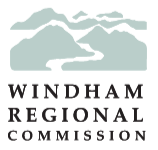Regional Profile
Geography
Situated in southeastern Vermont, the Windham Region consists of 23 towns in Windham County, the neighboring towns of Readsboro, Searsburg, and Winhall in Bennington County, and Weston in Windsor County. The region is bordered by Massachusetts to the south and New Hampshire to the east. At over 920 square miles (590,000 acres), the region accounts for roughly 9.6 percent of the State’s total land area and roughly 7.5 percent of the State’s total population. The Windham Region has several distinct sub-regions, defined by isolating topography and exhibiting similar economic and land use patterns.
The present-day Connecticut River Valley and adjacent Southern Vermont Piedmont is characterized by relatively flat and gently rolling land near the Connecticut River, with hills, small mountains, and narrow valleys in the uplands. Glacial processes left boulders and scrapped and scarred bedrock ledges, leaving behind deposits of clay, sand, and gravel. This process also included the formation of Lake Hitchcock, an extensive and valley-filling water body that contributed to the fertile agricultural soils now present in the region’s valleys. In more recent times, the Connecticut River and its tributaries have been instrumental in shaping the valley’s settlement pattern of villages and towns separated by fields and forests.
The Green Mountains are the principal element of physical geography in the western part of the region, with Stratton Mountain being the highest point in the region at 3,936 feet. This part of the region generally receives more precipitation and experiences lower temperatures because of its higher elevations. As a result, the main concentration of historic development is in the valleys, some of which are narrow while other high valley areas are surprisingly broad. Outlying areas mainly consist of large woodland areas on higher elevation land. The extensive forests in the Green Mountains along with productive lower elevation woodlands support a small but important forest-based economy throughout the region. The topography in the western part of the region also led to the development of ski areas and tourist resorts.
In addition to the Connecticut River, the other major rivers in the region are the Deerfield, Green, North, Saxtons, West, and Williams, all of which are tributaries of the Connecticut River. There are two major flood control reservoirs on the West River, the Ball Mountain and Townshend Dams. Somerset and Harriman Reservoirs are two major water storage reservoirs for hydropower generation on the Deerfield River.
Several significant transportation routes provide access to and through the Windham Region. There are two active rail lines in the region: the New England Central Railroad runs along the Connecticut River, hosting both freight and Amtrak passenger service, and the freight-only Green Mountain Railroad connects Bellows Falls to Rutland. Interstate 91 and U.S. Route 5 traverse the Connecticut River Valley north/south. Route 100 runs north/south through the Green Mountain in the western part of the region. Vermont Route 9, part of the National Highway System, provides east/west access from Brattleboro to Bennington, and between New Hampshire and New York. Vermont Route 103, also part of the National Highway System, connects Interstate 91 in Rockingham with Rutland in western Vermont. Finally, Vermont Route 30 runs north and west from Brattleboro through the West River Valley towns of Dummerston, Newfane, Townshend, Jamaica, and Winhall, eventually providing connection to the town of Manchester.
